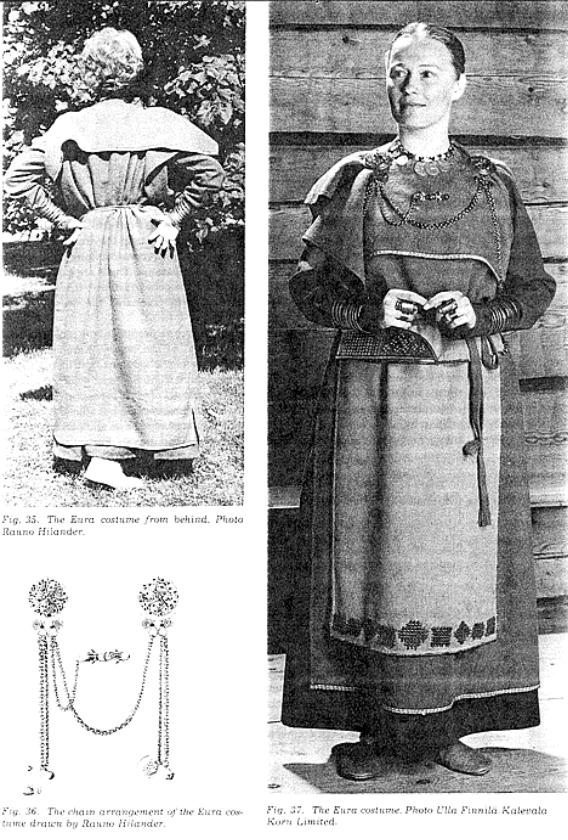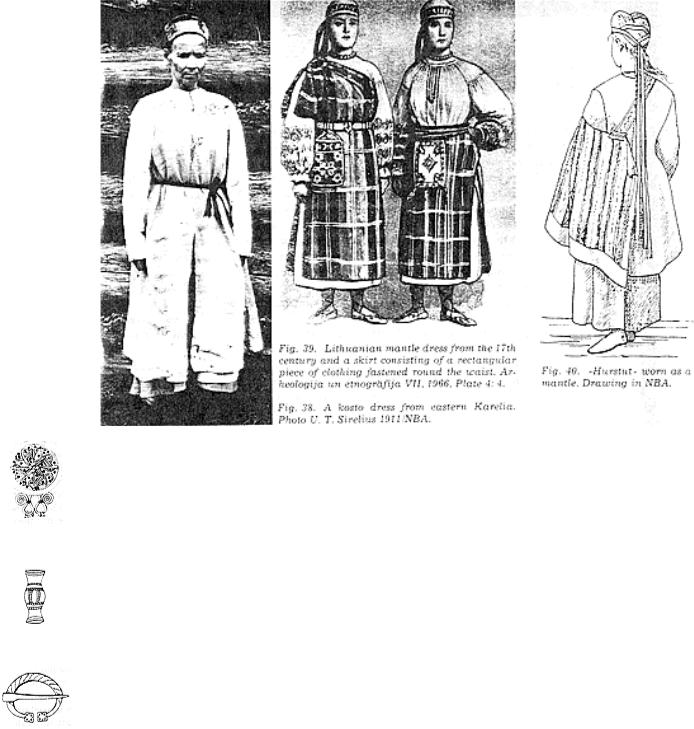
- •From Grave Finds to Reconstructions
- •Finnish inhumation cemeteries
- •Fabrics and materials
- •Sketches and Adaptations
- •The first pictures of ancient Finnish costumes
- •Ancient costumes on the stage
- •What the scientist said
- •Reconstructions for Exhibition and for Use
- •The Perniö costume
- •The first dress
- •The splendid spiral decoration
- •The Tuukkala costume
- •A dress for use
- •The Kaukola costume
- •A confusing interlude
- •Results of textile and colour analyses
- •The final reconstruction of the Eura costume
- •Development of fashion in other parts of Finland
- •Western traits in the east
- •The origin of Finnish spiral ornamentation
- •Pan-European trends of fashion?
- •Select bibliography
It was soon observed that a closed dress with wide folds was not especially becoming, but an open dress held up with shoulder brooches was both handsome and surprisingly comfortable to wear. Tied at the waist with the apron band it did not open disturbingly even when sitting down. A mantle-dress made of a rectangular piece of cloth, folded double at its upper edge and held in place with a brooch on the right-hand shoulder and with a belt at the waist was still in use in the Baltic region in the 17th century. Thus it is not at all impossible that a garment resembling this might have been used in Viking Age Finland. The use of two shoulder brooches, one on each shoulder, does not alter the basic idea of this garment very much.
The final reconstruction of the Eura costume
In the final reconstruction of the Eura costume there is a deep blue inner garment, an open mantle-dress fastened with brooches and a light green apron with bronze spiral ornamentation tied around the waist with a yellow red band. There is no mantle and no headdress in this costume, because the remains of these were so small that reconstruction would have been very uncertain. The sewn mittens are not yet reconstructed either. The shoes which are used with the Eura costume are made according to a pattern copied from early Medieval shoes in Scandinavia.
The threads for each garment in the first Eura costume were hand-spun with the same ply as was observed in the original threads. They were dyed with vegetable dyes, and many trials were necessary before the desired shades were obtained. The deep blue of the tunic was dyed with several indigo baths, the colour of the dress material was obtained by using heather, indigo and birch leaves, the yarns for the apron were dyed with nettle and indigo. The apron band was made of yarns dyed with the roots of Galium mollugo and Galium boreale. The same dyeing matters were used for the red threads of the tablet-woven band in the dress, and the blue in this was obtained by using indigo.
Model pieces for the fabrics were first woven of undyed yarns, later of dyed yarns. Only when both the thread thickness and the warp and weft density were right, were the final fabrics woven. Although a warp-weighted loom was not used, the dress and apron cloths were bordered with tablet-woven bands. With a horizontal loom starting borders are not necessary, and so the borders were made at the ends of the ready-woven cloth. The model for the tablet-woven end borders of the dress was taken from that of the apron. This detail was not preserved in the dress fragments found in the Luistari grave, but a tablet-woven band seemed to be the right way of bordering the open dress which was the result of the reconstruction.
All the details of the Eura costume were tried out in practice before the final reconstruction was presented. So this costume is comfortable to wear, although it is made entirely of wool. However, it must not be thought that women in ancient Finland always wore a dress like this. Probably they went about their work dressed in a woollen or linen tunic and had perhaps at their waist a simple apron without bronze ornaments.
A mantle-dress, a veil and a cloak could be added to this garb in cold weather. On festive occasions the brooches and chains, bracelets and finger-rings, and especially the spiralornamented apron were used. The woman in the Luistari grave had been furnished for all occasions.
Fig. 35
Fig. 39
Fig. 29
Fig. 37
52

53

Uniform and Dissimilar Fashion
Women's costume and its ornaments in Western Finland during the late Iron Age
The Eura costume seems to differ in many respects from the other dresses reconstructed. These differences perhaps appear greater than they really are. It is not impossible that in the graves on which the other reconstructions have been based the dresses have been similar to the Eura costume. There are both in the western and eastern Finnish material shoulder brooches fastened to edge fragments bent double, and Theodor Schvindt already compared the dress of the Karelian women to the Greek peplos.
The dress with broad shoulder straps could only be a product of the reconstructors' fantasy, inspired perhaps by the kosto dress of the eastern Karelians. The shape of this old-fashioned costume as a whole' is the same as that in the first reconstructions; the straps only are sewn together in front. So far no clear evidence for this type of shoulder dress in ancient Finnish graves has been presented. It must however be remembered that shoulder brooches do not appear in every woman's grave. There must have been different garments in use, and perhaps only the richest women got their shoulder dresses in the graves. Perhaps the most common garment was a woollen or linen smock, and the mantle-dress was an outer garment.
There could also have been mantle-dresses of different forms. Perhaps some of them had only a band over the shoulder like the huTstut-garment in Karelia and Inkeri. The others could have been fastened with a knot in upper corners or with only one pin or brooch in the same place. As already mentioned a mantle dress like this is known from Lithuania from the 17th century. And there is also the skirt made of a rectangular piece of fabric and fastened with a band round the waist.
The possibilities are many, but unfortunately on the basis of the finds we can only follow the development of the dress fastened with brooches.
The appearance of the dress fastened at the shoulders dates back to the 7th century in western Finnish finds. There is some evidence of double pins used during the older Iron Age, but it is not possible to say whether they indicate the Baltic mode of carrying a.mantle or whether they prove the existence of a dress fastened at the shoulders.
Pairs of shoulder brooches pointing to the existence of a mantle-dress are known from every century of the later Iron Age in closed connections. However. only in graves from the end of the 10th century onwards are the shoulder brooches and the other ornaments connected with them so common that they can be considered usual.
The first ornaments appearing with certainty in pairs are small round and equal-armed brooches from about the year 600 A.D. With them there is often a third brooch called the crayfish brooch. which probably fastened the mantle. Sometimes
54

a chain joined all of them. Two or four bracelets and a couple of finger-rings often completed the combination, but only a few women had neck rings or glass beads round their necks. The material of all their ornaments was usually bronze.
At the end of the 8th century bow-brooches of iron were sometimes used at the shoulders, but from the beginning of the Viking Age round brooches dominated the fashion. In addition to the shoulder brooches the third brooch could be round, but also equal-armed brooches appeared as mantle ornaments. At the end of the Viking period penannular brooches were also used for this purpose.
Contrary to the belief usually adopted chains were not usual during the Viking Age in Finland. Although there are some finds with chains from the 9th century, it is only towards the end of the 10th century that the heavy chain arrangements became the fashion. Apparently a bead band was the most popular ornament of most Finnish women, and beads were imported from east and west.
Bracelets and finger-rings continued to be in vogue, and especially armrings could be very heavy. From a single Viking Age bracelet about a dozen ornaments of the foregoing period could have been cast. The ornaments were still mostly of bronze; only at the end of the Viking period did silver brooches and rings become common. Very few ornaments were gilded.
At the end of the 11th century in Finland Proper and in Satakunta women began to wear small penannular brooches at the shoulder. On the other hand there is also evidence that about that time they began to sew the shoulder parts together. The role of shoulder brooches as an ornament disappeared when mantles with rich spiral decoration came into fashion.
55
